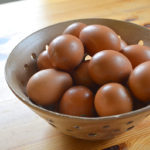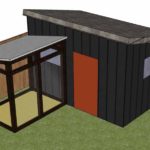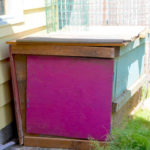This larger, more serious problem I noticed a few days ago. Mounded soil, like a mole hill, began appearing right inside the coop fence with a small hole. I narrowed the culprit down to either a rat or an opossum. The critter did not seem to be after the hens sleeping upstairs in the hen house, so I assumed it was coming in to steal food under the cover of darkness.
I searched for the entry point to the tunnel on the outside of the coop to no avail. An hour or so later, I had managed to detach the hen house from the run and moved both away from the coop site. Unfortunately, when I moved the hen house, I discovered large droppings under the floor which sits about 4″ above ground resting on cinder blocks. Ew: A rat had taken up residence.
Mice = I can deal with. Rats = yuck.
I still hadn’t found the source of the hole, so I began moving cinder blocks. I traced the hole under several cinder blocks until it eventually went underground deeper. This is all a rather disgusting treasure hunt I had been on. I was now deciding whether to fill the hole, cover it with a heavy object, or flush it out. I figured I would flush it out with water to discourage the rat from returning to live in damp quarters.
Here I am: three inches from the ground, crouched over a gross rat hole, shoving a hose down there and filling it with water. Everything seems to be going fine. Sometimes the water gets plugged up, so I shove the hose further down until the water gets cleared again. A couple minutes into this endeavor, the water begins gurgling. An air pocket perhaps is rising to the surface. But, no…
A GIANT RAT!!! It flies out the hole, inches from my fingers, right in front of my face! It’s little beady eyes… It’s wet, scraggly fuzzy fat body goes scurrying across the yard!
Pearl, my old americuana, decides to make a run for it. Hey, protein is protein I guess. Luckily (I think?), Pearl was not fast enough and the rat got away.
Why do I share this totally jarring, gross story with you? It’s entertaining. It’s disgusting. And it is just one of those ridiculous stories that comes with the territory of keeping urban livestock. I have been so fortunate to avoid run-ins with pests and disease in general, but it is all too common to have an occasional pest problem.
The next step is to trap the rat and I look forward to returning to the days of pest-free chicken keeping.






 This cluster was about the siz
This cluster was about the siz




 I start with a
I start with a


Oh my gosh did the neighbors hear you scream? lol I would have that is for darn sure EWWW. But I do have to say I did chuckle at the mental picture you painted! lol
Garden hose down the rodent hole… Did you feel the urge to start reciting Bill Murray lines from Caddyshack?
We had rats once. Rats, as in plural. Watch out for number 2. Thanks for the great blog.
I’m sorry dear, but your lovely Pearl is an Easter Egger and not an ‘americuana’.
“Easter Egg Layers or Rainbow Layers”…are by far the most common “blue egg layer” sold by most commercial hatcheries, local feed mills, and farm supply stores. This type of chicken is commonly referred to as an “Araucana” or “Americana/Araucana” but the fact is these chickens are neither a purebred Araucana or an Ameraucana but they are a mixed-breed/mongrel variety. Some hatcheries are starting to refer to them as “Easter Egg Layers” or “Rainbow Layers” but many people and hatcheries still erroneously call them “Americanas” (often seen mis-spelling of Ameraucana) or “Araucanas”.
Easter Egg Layers typically lay an olive or khaki green egg or a pale beige egg sometimes referred to as “pink”, but many lay pastel blue or green eggs as well, but this does not mean they are an Ameraucana. Although they come in countless different colors and patterns they often resemble Ameraucanas with similar feather color and patterns. Some, but not all Easter Egg Layers sport muffs and/or beards but there is usually no consistency in type or coloring since they are a mixed breed and do not breed true to type.
You have a pretty and friendly girl, that’s for sure – but she is a classic EE. I have some myself, and they are my favorites but they are not Ameraucanas and never ‘americuanas’.
http://www.ameraucana.org/
Thanks for the long comment Liz! I know there is a lot of confusion over using the breed name Araucanas vs. Americanas vs. “Easter Egg” hen, etc. I use Americana, knowing she is perhaps not actually the true breed, for simplicity since it seems to be the most commonly used term among city chicken keepers, in feed stores and with major hatcheries.
Thanks for sharing though that chickens labeled as such are rarely the true breed!
1. What a great site, thanks!
2. Thanks for the flushing idea, it is such a Caddyshack idea that I would have hesitated to use it
3. If you want a bird that lays eggs, can live with chicks and would probably kill the rat go Guinea hen, specifically hen not “fowl” which includes males. If you can get just females & get them used to noise from the start, I have found, they less noisy which is their only downside.